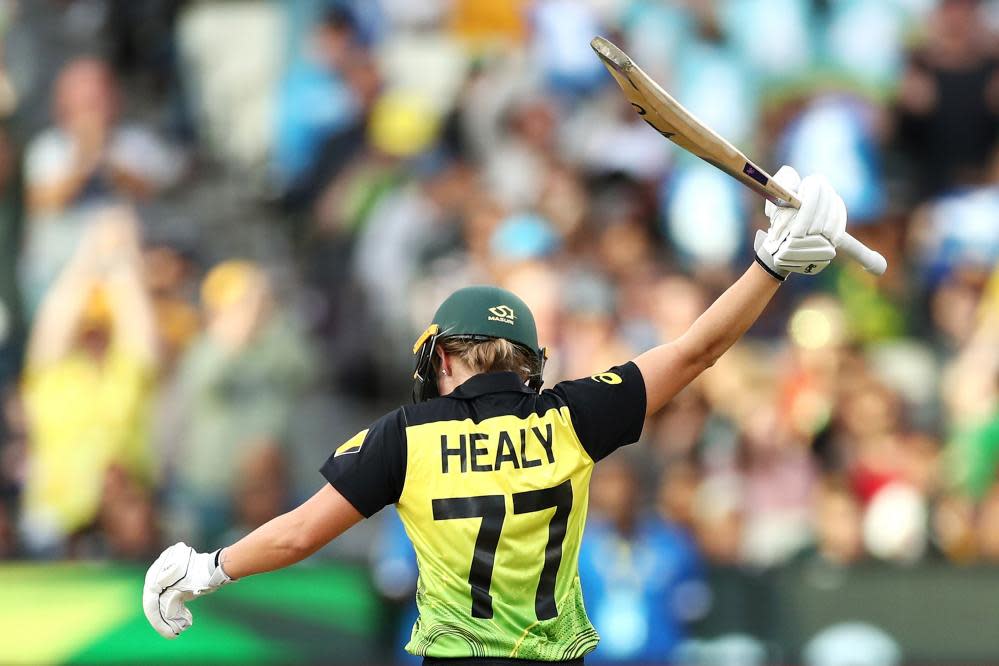Alyssa Healy uses Covid downtime to break down barriers for women's cricket

When Alyssa Healy last played a game of cricket it was in front of 86,174 people, with millions more tuning in around the world. As she smashed 75 from 39 balls to the roar of the crowd and the team danced the night away with Katy Perry, it felt like a turning point.
And then, of course, everything changed. Cricket in Australia was one of the less affected sports, but the national women’s team had a tour of South Africa postponed and players who were scheduled to take part in The Hundred found themselves spending winter at home.
Despite the seriousness of the situation, Healy has enjoyed the unexpected downtime and says it has in some ways been a blessing in disguise for many players. “We’ve been flat-out for the last two to three years, so for us to be able to spend some time at home, it’s such a rare thing,” she says.
Related: Lydia Greenway: 'Girls need the right kit, that's why we're doing this'
The world’s second-ranked ODI batter is now back training with her team ahead of a spring series against New Zealand and the sixth season of the Women’s Big Bash League. But she has been able to put the time at home to good use, consulting with sports apparel manufacturer Asics on the development of a women’s cricket shoe.
Women have been playing cricket in Australia for well over 100 years, but for much of that time they have had to use clothing and equipment designed for men. Change is under way, but it has been slow, and Healy and her teammates have had to adapt to shoes that are not designed for women’s feet.
“We obviously don’t have the same shape of foot as the boys do – I live at home with one who’s 6ft 5in and wears a size 14 and I know that we are definitely very different,” says Healy of her husband Mitchell Starc. “So to be able to have one that fits snugly to the female foot and protects our feet while we’re playing is really important.”
The growth in demand for women-specific cricket equipment is another sign of how far the game has come in recent years. For Healy, it sends an important message to women that they are welcome in the sport.
“Having stuff like this growing up would have reinforced that I can play the game and there’s equipment out there available for me, in my size and in my shape,” she says. “Growing up, you sort of just had to deal with wearing a junior boys’ cut or whatever you were given but now [there are] other options for the young girls out there.”
While the equipment itself is important, equally so is the language used in the sport to create inclusive environments. Over the past few years, Cricket Australia has recognised the importance of terminology, now preferring the neutral terms “batter” and “fielder” to recognise their diversified audience and playing group.
The decision to consistently refer to the national teams as the Australian men’s and Australian women’s cricket teams has reinforced this commitment to equality – no longer are men seen as the default gender in the sport.
“Kookaburra recently changed their sizing from men and boys to just juniors and adults and made it easy for everybody to go in and find something that they need,” Healy adds. “And it will just encourage more girls to take up the game, but also to stay in the game when they feel like there’s stuff out there that is made just for them.”
Although there is no shortage of inspiration for young girls to pick up a bat through the WBBL and the dominant national side, keeping teenage girls in sport has long been an issue. It only takes a few barriers – whether they be ill-fitting equipment or outdated terminology – to send a message to a young player that she is not welcome.
At 30, Healy is still in the prime of her career, but she is hopeful about what the future holds for this next generation of women’s cricketers now these barriers are gradually being broken down. Although she is delighted with the progress over the past few years, she believes full-time professionalism is the next step.
“At the moment there are only 14 players that are gifted the opportunity to be full-time professional cricketers,” she says. “So …I’d love to see the domestic game fully professional for the young girls out there.
“The way that the WBBL has progressed over its five seasons has been really impressive and it just shows the time and effort that the young girls are putting into their sport at that level, very much on a part-time basis. To see that go fully professional I think is going to do wonders for the sport, but also for the Australian team – it will remain strong for a long period of time if that happens.”

 Yahoo News
Yahoo News 
